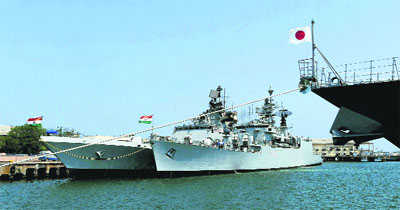
Indian and Japan navy ships during the five-day Exercise Malabar-2015, on the Eastern coast, at the Port Trust in Chennai. PTI
Shyam Saran
INDIAN policymakers are often criticised for their apparent lack of a strategic culture, even a world view, through which to understand the world around us and engage with it to advance a set of objectives influenced by geography, history, culture, a certain identifiable national temperament. I can do no better than quote from Jawaharlal Nehru, who articulated the sensibilities that drive the people of India and shape their view of the world and their place in it. He saw India as a civilisational entity, coming into its own after a long and eventful and yes a painful journey, to keep its tryst with destiny.
India’s tryst with destiny in 1947 was a culmination of this journey, a chance to dream again. But Nehru saw that these were dreams not just for India but “they are also for the world” because he saw, prophetically, a world too closely knit together to flourish in fragmented isolation. He welcomed the initial achievements of a rule-based multilateral order which the US, in a brief phase of enlightened self-interest, took the lead in creating. But he saw the swiftly emerging divisions of the Cold War as shrinking India’s own hard-won space as an independent and sovereign nation. Non-alignment was a means to maintain India’s strategic space, to continue on its civilisational journey and not succumb again to having its destiny determined by others. But Nehru is long gone, the Cold War is over and the world around us has been changing in ways that are profound and yet deeply uncertain. But the basic prism through which independent India has sought to engage with the world has remained remarkably consistent.
We are witnessing the relentless dismantling of the post-World War II global order created and dominated by the US and its Western allies, but the change is more rapid and far-reaching in some respects, less in others. For example, the most significant and visible is the continuing shift of the centre of gravity of the global economy, international trade and investment from the trans-Atlantic to the Asia-Pacific. The global financial and economic crisis accelerated this trend. The recent slowdown in the Chinese economy and continuing inability of the Indian economy to regain a higher trajectory of growth may retard this trend. It is unlikely to change it.
Against this backdrop how does India seek to advance its interests? What is the underlying template which guides its foreign and security policies? In my view, the template is India’s concept of its strategic neighbourhood and the need to secure this neighbourhood, seen as a prerequisite to the pursuit of any credible regional or global role. India considers the entire Indian subcontinent and the ocean space around it as its strategic neighbourhood.
This extended neighbourhood, in turn, had a major influence in shaping India’s identity as a diverse and plural entity but with a strong and enduring sense of cultural affinity. As India’s external profile develops and expands, it is along these remembered pathways that it will begin to manifest itself. Nehru’s eloquent narrative on India’s worldview was inspired by its history as a cross-roads culture, enriched by the long centuries of maritime interaction, both east and west borne along by the monsoon winds and the caravan routes that linked it to Central Asia and China. The Indian subcontinent and the ocean space around it constitute a single geopolitical unit, with dense economic complementarities, a common history and strong cultural affinities. This remains a strategic singularity despite being fragmented into several independent and sovereign states that do not have a shared security perception. However, as the largest entity, India’s strategic compulsions are still defined by subcontinental imperatives. It cannot conceive of its defence within the confines of its own borders. The situation is made more complex by the fact that there are overlapping ethnicities, linguistic and kinship ties which spill across national boundaries. There are shared assets like rivers and forests but their use may be contested. Since India's Independence, Indian leaders have confronted the perennial dilemma of reconciling the country’s subcontinental security imperatives with the reality of a divided polity. A Pax Indica which could enable India to compel its neighbours into aligning their security perspectives with that of India is a remote possibility. The alternative is to use a mix of political, security, economic and cultural policies to create a dense web of interdependencies which, over time, lead to the alignment of security perspectives with that of India. The aim would be to try to transcend borders, not seek to erase them and transform a contested space into one enjoying relative harmony and a broad political consensus. This has been the basic tenor of India’s neighbourhood strategy over the past decade and a half but has achieved only partial success.
***
With China, there has been greater success in keeping relations on an even keel and mechanisms are in place to deal with incidents at the border. With Pakistan, the continuing use of cross-border terrorism as an instrument of state policy has made it difficult to develop relations in other fields, including trade, while reserving differences over Kashmir.
China is one country which impacts most directly on India’s strategic space. The unresolved boundary, the shadow of the Tibet, the Chinese use of Pakistan as a convenient proxy to constrain India and now its increasing presence in the Indian Ocean, these difficult issues which need to be managed carefully. There is the uncomfortable reality that the asymmetry between the two Asian giants is increasing. This imbalance limits India’s room for manoeuvre. India has attempted to deal with this challenge through a policy of engagement with China, building on areas of convergence even while constraining its predilection towards the unilateral and sometimes aggressive assertion of power. The latter requires expanding India’s deterrent capabilities including upgradation of infrastructure at the border but also strengthening security ties with countries in the region that share our concerns over Chinese behaviour. India has welcomed the US rebalancing to Asia but is unable to understand its posture leading to the crisis in Ukraine. Russia has been pushed closer to China, which is now the pivot in the triangular relationship among China, Russia and the US. For India, the closer relationship Russia has with China reduces the value of our longstanding and cooperative engagement with Russia. Russia may not be as supportive as in the past in dealing with India–China issues and even India–Pakistan issues in the future.
The US seems to have been concerned about the growing partnership between Putin’s Russia and Germany. However, the US may be neglecting the even more serious inroads China has been making in Europe, taking advantage of the continent’s persistent economic and financial crisis. China has been acquiring modern infrastructure and logistics bases across Europe and is using the UK as a key base for developing its offshore financial market. The US has been unable to restrain its European allies from embracing a much expanded economic partnership with China, which could impact on the trans-Atlantic security relationship.
India’s own relationship with Europe has fallen off the radar even as its ties with Germany have expanded. In 2004, India and the EU established a strategic partnership and acknowledged that each had a stake in the other’s success as open, liberal and plural democracies.
***
China with its financial resources and large market has proved to be a tempting partner and Europe, in particular the UK, has allowed economic compulsions to override any political scruples. It is not only in Asia that China is attempting to create distance between the US and its allies. The same is happening in Europe as well.
The Gulf and West Asian region remains the key source of oil and gas supplies even though there is a steady effort to diversify. There are six million Indians who live and work in the Gulf and any political turmoil and violence would directly affect their welfare and India may face the contingency of evacuating large numbers of its citizens at exorbitant cost. India’s access to Central Asia is through Iran and this route may also be affected by developments in the Gulf. Lastly, the sectarian conflict in the region, the growing proxy war between Saudi Arabia and Iran and the rise of ISIS – all these could have a negative impact on India’s own secular social fabric.
***
There has also been a significant rise in India’s trade and investment relations with other countries in the region including Japan and South Korea, with both of whom India has concluded comprehensive economic partnership agreements. A similar agreement is likely to be reached with Australia, hopefully in the next few months. While there is no trade agreement of a similar kind with China, it is one of India’s largest trade partners and increasingly an important investor in India. Thus, the region has emerged as the most dynamic component of India’s external economic relations. This has now been paralleled by a network of defence and security relationships with several ASEAN and East Asian countries, with a particular focus on maritime security. In this respect, the most significant development has been the expansion of India–US maritime cooperation in the Asia-Pacific, with the US conducting the largest number of naval exercises with India. There is a possibility that the idea of a ‘quad’, including India, Japan, Australia and the US, may be revived despite the strong opposition of both China and Russia. With China building artificial islands and bases in the South China Sea and asserting claims over virtually the entire ocean space, it would only be prudent to have a strong and credible counter force available. However, India continues to advocate, as an alternative, an inclusive security architecture in the region that can take care of legitimate concerns of China as well as other stakeholders. India has increased its presence in the South China Sea and the Western Pacific. This is likely to continue as India plans to devote a larger proportion of resources to its Navy in the coming years. India sees its naval strength as compensating, to some extent, the subcontinental dilemma I mentioned earlier. It should come as no surprise that India’s major preoccupations remain rooted in its immediate and extended neighbourhood. Nevertheless, it sees its expanded engagement with other major powers as a positive factor in managing these preoccupations. The Modi government has pursued a remarkably active regional and global foreign policy, which he also seeks to leverage to advance India’s economic prospects.
In addition to a sense of itself as a civilisational entity, India’s size assures it a global profile. While its indices of per capita and social welfare may still lag far behind developed countries, it has a large global and macro impact because of its sheer weight in the global economy. Choices India makes on its energy security or the progress it achieves on global health issues such as the eradication of polio have a decisive impact on tackling a range of global challenges such as climate change or the ability to handle global pandemics. In areas such as cyber and space, India has developed substantial capabilities which could place it among the front-ranking nations of the future.
***
A high growth trajectory of 9–10 per cent per annum for the next 20 years, without sacrificing ecological sustainability, will make India one of the leading powers of the current century. The election of Prime Minister Modi with a parliamentary majority has opened up prospects for India finally delivering on its acknowledged economic promise. It would also demonstrate that a plural and sometimes messy democracy need not be a constraint on rapid development. It may prove to be the one key ingredient of sustainable and inclusive development.
Excerpts from a lecture by the writer, a former Indian Foreign Secretary, at Lowy Institute for International Policy, Sydney, Australia.


























